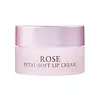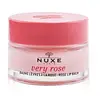What's inside
What's inside
 Key Ingredients
Key Ingredients

 Benefits
Benefits

 Concerns
Concerns

 Ingredients Side-by-side
Ingredients Side-by-side

Isononyl Isononanoate
EmollientC10-30 Cholesterol/Lanosterol Esters
EmulsifyingBis-Diglyceryl Polyacyladipate-2
EmollientCera Microcristallina
Emulsion StabilisingPolybutene
Ethylene/Propylene/Styrene Copolymer
Glyceryl Behenate/Eicosadioate
EmollientPrunus Armeniaca Kernel Oil
MaskingButylene/Ethylene/Styrene Copolymer
Ribes Nigrum Seed Oil
EmollientVitis Vinifera Seed Oil
EmollientRosa Damascena Extract
MaskingRosa Damascena Flower Oil
MaskingTocopherol
AntioxidantAscorbyl Palmitate
AntioxidantSilica Silylate
EmollientBenzotriazolyl Dodecyl P-Cresol
UV AbsorberParfum
MaskingPentaerythrityl Tetra-Di-T-Butyl Hydroxyhydrocinnamate
AntioxidantCI 77891
Cosmetic ColorantBHT
AntioxidantPolyglyceryl-2 Triisostearate
EmulsifyingWater
Skin ConditioningTrimethylolpropane Triisostearate
EmollientCI 15850
Cosmetic ColorantCI 15985
Cosmetic ColorantPropyl Gallate
AntioxidantCitronellol
PerfumingGeraniol
PerfumingLimonene
PerfumingIsononyl Isononanoate, C10-30 Cholesterol/Lanosterol Esters, Bis-Diglyceryl Polyacyladipate-2, Cera Microcristallina, Polybutene, Ethylene/Propylene/Styrene Copolymer, Glyceryl Behenate/Eicosadioate, Prunus Armeniaca Kernel Oil, Butylene/Ethylene/Styrene Copolymer, Ribes Nigrum Seed Oil, Vitis Vinifera Seed Oil, Rosa Damascena Extract, Rosa Damascena Flower Oil, Tocopherol, Ascorbyl Palmitate, Silica Silylate, Benzotriazolyl Dodecyl P-Cresol, Parfum, Pentaerythrityl Tetra-Di-T-Butyl Hydroxyhydrocinnamate, CI 77891, BHT, Polyglyceryl-2 Triisostearate, Water, Trimethylolpropane Triisostearate, CI 15850, CI 15985, Propyl Gallate, Citronellol, Geraniol, Limonene
Helianthus Annuus Seed Oil
EmollientButyrospermum Parkii Butter
Skin ConditioningCera Alba
EmollientC10-18 Triglycerides
EmollientCaprylic/Capric Triglyceride
MaskingParfum
MaskingOleic/Linoleic/Linolenic Polyglycerides
EmollientTocopherol
AntioxidantGlyceryl Caprylate
EmollientRosa Centifolia Flower Extract
AstringentLithospermum Erythrorhizon Root Extract
Skin ConditioningSimmondsia Chinensis Seed Oil
EmollientCitric Acid
BufferingBenzyl Benzoate
AntimicrobialIsoeugenol
PerfumingHelianthus Annuus Seed Oil, Butyrospermum Parkii Butter, Cera Alba, C10-18 Triglycerides, Caprylic/Capric Triglyceride, Parfum, Oleic/Linoleic/Linolenic Polyglycerides, Tocopherol, Glyceryl Caprylate, Rosa Centifolia Flower Extract, Lithospermum Erythrorhizon Root Extract, Simmondsia Chinensis Seed Oil, Citric Acid, Benzyl Benzoate, Isoeugenol
 Reviews
Reviews

Ingredients Explained
These ingredients are found in both products.
Ingredients higher up in an ingredient list are typically present in a larger amount.
Parfum is a catch-all term for an ingredient or more that is used to give a scent to products.
Also called "fragrance", this ingredient can be a blend of hundreds of chemicals or plant oils. This means every product with "fragrance" or "parfum" in the ingredients list is a different mixture.
For instance, Habanolide is a proprietary trade name for a specific aroma chemical. When used as a fragrance ingredient in cosmetics, most aroma chemicals fall under the broad labeling category of “FRAGRANCE” or “PARFUM” according to EU and US regulations.
The term 'parfum' or 'fragrance' is not regulated in many countries. In many cases, it is up to the brand to define this term.
For instance, many brands choose to label themselves as "fragrance-free" because they are not using synthetic fragrances. However, their products may still contain ingredients such as essential oils that are considered a fragrance by INCI standards.
One example is Calendula flower extract. Calendula is an essential oil that still imparts a scent or 'fragrance'.
Depending on the blend, the ingredients in the mixture can cause allergies and sensitivities on the skin. Some ingredients that are known EU allergens include linalool and citronellol.
Parfum can also be used to mask or cover an unpleasant scent.
The bottom line is: not all fragrances/parfum/ingredients are created equally. If you are worried about fragrances, we recommend taking a closer look at an ingredient. And of course, we always recommend speaking with a professional.
Learn more about ParfumTocopherol (also known as Vitamin E) is a common antioxidant used to help protect the skin from free-radicals and strengthen the skin barrier. It's also fat soluble - this means our skin is great at absorbing it.
Vitamin E also helps keep your natural skin lipids healthy. Your lipid skin barrier naturally consists of lipids, ceramides, and fatty acids. Vitamin E offers extra protection for your skin’s lipid barrier, keeping your skin healthy and nourished.
Another benefit is a bit of UV protection. Vitamin E helps reduce the damage caused by UVB rays. (It should not replace your sunscreen). Combining it with Vitamin C can decrease sunburned cells and hyperpigmentation after UV exposure.
You might have noticed Vitamin E + C often paired together. This is because it is great at stabilizing Vitamin C. Using the two together helps increase the effectiveness of both ingredients.
There are often claims that Vitamin E can reduce/prevent scarring, but these claims haven't been confirmed by scientific research.
Learn more about Tocopherol